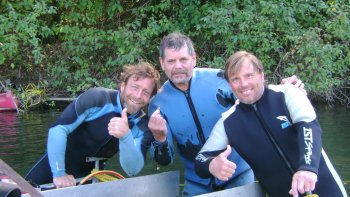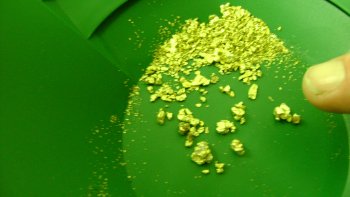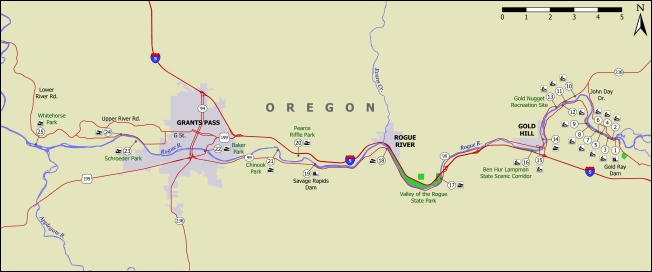
FOURTH QUARTER, SEPTEMBER 2009 VOLUME 23, NUMBER 10

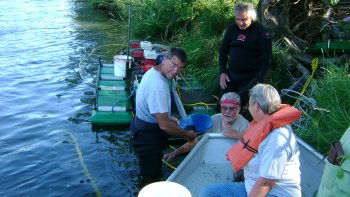
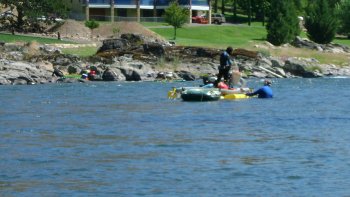
Within days after Governor Schwarzenegger signed Senate Bill 670 into law, we were already in planning to launch a week-long group dredging sampling program onto the Rogue River in Southern Oregon. This was going to be a vitally important mission for The New 49’ers. So I only invited very experienced dredge miners to participate. Our success was the result of hard, dedicated work by the following members: Robert Green, Dan Christenson, Ken Eddy, Mike & Rachel Dunn, James & Denise McCarville, Alan Mash, Craig Colt, Mike & Shawn Higbee, Jim Yerby, Tom & Pat Harris, Jesse Fence and Joelle Stine.
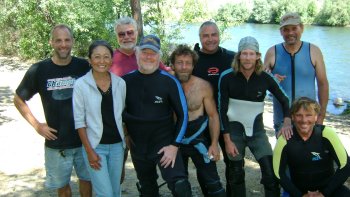
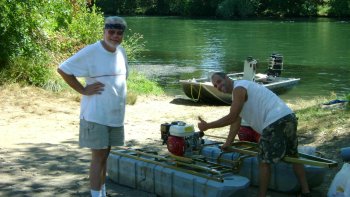
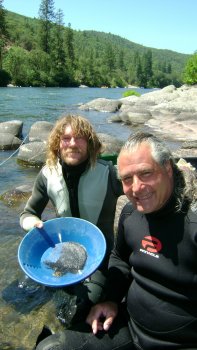
There are several good reasons why we targeted the Rogue River on this project. The first, of course, is that California just recently passed a law which has imposed a moratorium upon any further suction dredging until the Department of Fish & Game (DFG) completes an updated Environmental Impact Report (EIR) on the affects of suction dredging and adopts new regulations, if necessary. While it is our intention to challenge the new law (please see next section below), there are no guarantees the process will be completed anytime soon. The New 49’ers has a responsibility to provide mining opportunities for our members. Some of our members prefer suction dredging over other types of mining. Therefore, once the governor signed SB 670 into law, we immediately started looking for suction dredging opportunities outside of California.
One nice thing about the Rogue is that the section of river we chose is not any further away than Happy Camp for members traveling north on Interstate 5. Gold Hill (one of several places where the Rogue crosses Interstate 5) is only around 9 miles to the north of Medford (Oregon). We were looking for a place which is not too distant from our main headquarters in Happy Camp.
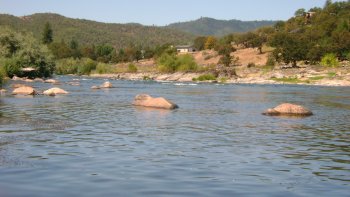
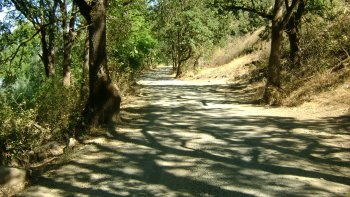
We have also been looking at the mining history of the Rogue River in the area around Gold Hill and Grants Pass. This history is good! Still, even though we have been hearing good reports for years, before encouraging our members to go over there, I personally wanted to see high-grade gold being recovered out of the river.
In gold mining, seeing is believing!
Within the past year or so, Oregon courts have confirmed the validity of a law which declared the Rogue River as “navigable.” This is a legal term which places the entire river and its bed under the ownership of the State of Oregon. This means that there is no private property, and there are no mining claims, between the normal high water marks of the river. Oregon has placed the entire 37 mile section of river between the Gold Ray Dam and the Applegate River in a “recreational” status. This means the river is open to rafting, boating, fishing, swimming; and yes, suction dredging.
Click on the map to see the full size version with links to points of interest and river access.
As the stretch of river between the Gold Ray Dam (about 8 miles from Medford) and the Applegate River (downstream from Grants Pass) is a very long one, all of which is gold-bearing, and our time for this project was limited to about a week, we decided to begin within a few miles downstream of the Gold Ray Dam. This is an area where several of our project-participants had previous experience in dredging high-grade gold. We still have a lot to learn about this Rogue River. Our immediate mission was mainly to prove conclusively that high-grade is present there now! So we started in an area where others had found it before.
Here follows a video segment put together to give you an idea what the surrounding area looks like along the Rogue River in the area we were sampling:
This was not one of those types of projects where we needed to provide any teaching or guidance for the members who participated. Everyone present already knew what to do. Mainly, we coordinated our sampling program amongst ourselves to make our progress more effective. I brought a boat along so I could help participants get their gear across the river and sometimes up and down the river.
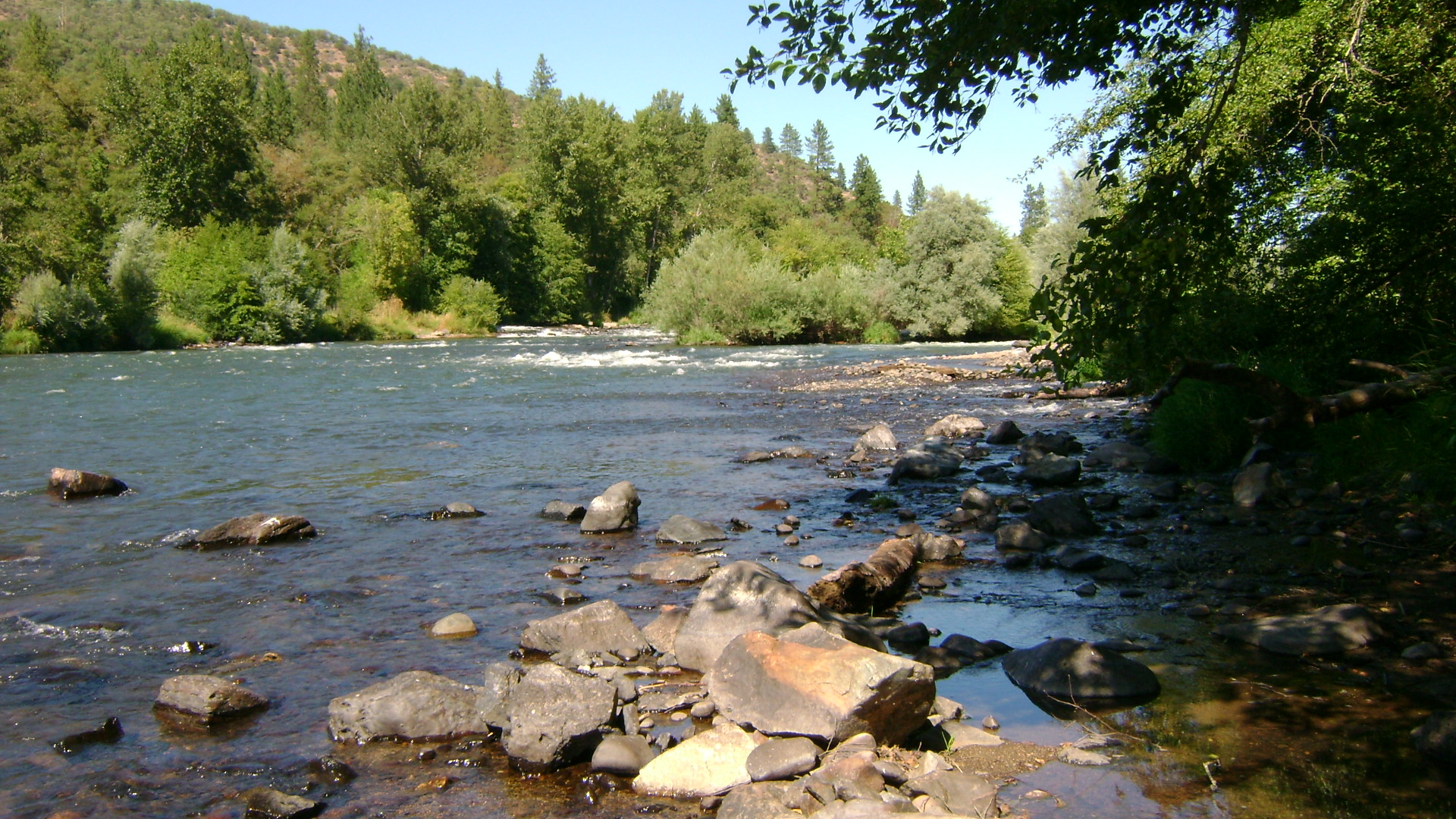
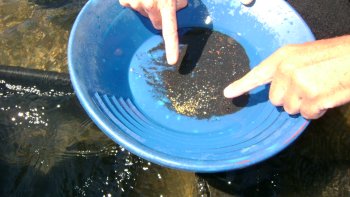
We had seven dredges participating in the project. All or most of them were recovering gold on the first dive. Within the first two days, it became clear that the Rogue River is producing gold from one bank to the other! Several participants were into high-grade gold within the first few days. Interestingly, at least in the sections where we sampled, we found that much more of the river has yet to be dredged, than what has been dredged before. This is true even in some of the most accessible areas.
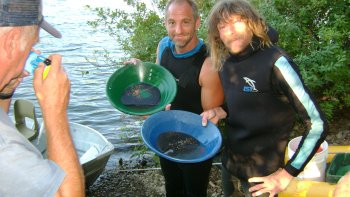 Here follows a video segment which captured the excitement and satisfaction Craig and Mike were experiencing just as they started uncovering high-grade gold in one section of the river:
Here follows a video segment which captured the excitement and satisfaction Craig and Mike were experiencing just as they started uncovering high-grade gold in one section of the river:
Here is another thing we discovered to our amazement: Even though the Rogue is a wide river like the Klamath, you generally do not have to dredge very deep to reach the bedrock, or a false bedrock which is made up of cemented gravel. The average depth of gravel we were dredging to the pay-dirt was less than two feet. Our samples were turning up gold results weighing in the pennyweights in places where several local dredgers told us that they ruled out as “not good enough to dredge.” With more time, I am certain we will find even higher-grade gold deposits! Mainly, for starters, we wanted to make sure the gold is there.
The gold is definitely there!
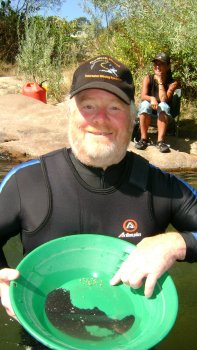
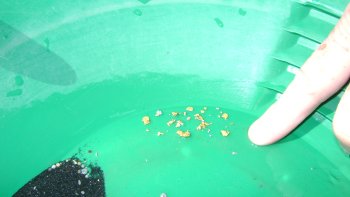
As you will be hearing plenty more about this over the next several months, let me just begin with some of my own initial observations:
![]() While the Rogue River is big and wide (in places), we found that there is an abundance of slow, shallow water where you do not have to dredge very deep to reach bedrock or the cemented gravel layer. We were finding good gold in the hard-packed layer right on top. Fine gold, and some nuggets, seems to be spread all across the river. There is a lot of slow, easy water where beginners can learn without getting in over your heads. My initial impression is that beginner-dredgers will have an easier time getting into gold on the Rogue, than along the Klamath River.
While the Rogue River is big and wide (in places), we found that there is an abundance of slow, shallow water where you do not have to dredge very deep to reach bedrock or the cemented gravel layer. We were finding good gold in the hard-packed layer right on top. Fine gold, and some nuggets, seems to be spread all across the river. There is a lot of slow, easy water where beginners can learn without getting in over your heads. My initial impression is that beginner-dredgers will have an easier time getting into gold on the Rogue, than along the Klamath River.
Here follows a video segment which we captured of James & Denise talking about how nice the area is, showing off some of the gold they were finding, and talking about their plans of returning to the Rogue River next year:
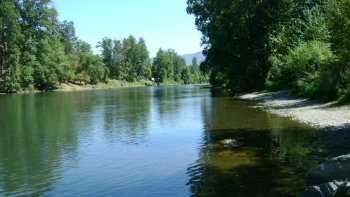
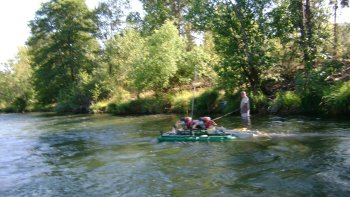
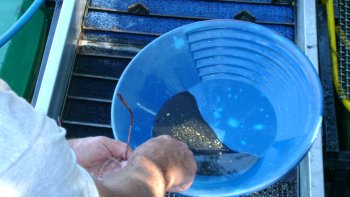
![]() There also seems to be a ripe opportunity for more-serious dredgers. We only saw a few dredgers working the river while we were over there. So we took the opportunity to meet them. Besides being hospitable and friendly, they were also very helpful with historical information about the area. They passed along some very encouraging stories of fantastic gold recoveries which have been made by a few more-experienced suction dredgers along the Rogue River. Based upon their information, it only took us a few hours before we were recovering beautiful gold nuggets just by busting open cracks along exposed bedrock in a slow, shallow section of the river! With time, I am sure we can tap into the really rich sections of this long river.
There also seems to be a ripe opportunity for more-serious dredgers. We only saw a few dredgers working the river while we were over there. So we took the opportunity to meet them. Besides being hospitable and friendly, they were also very helpful with historical information about the area. They passed along some very encouraging stories of fantastic gold recoveries which have been made by a few more-experienced suction dredgers along the Rogue River. Based upon their information, it only took us a few hours before we were recovering beautiful gold nuggets just by busting open cracks along exposed bedrock in a slow, shallow section of the river! With time, I am sure we can tap into the really rich sections of this long river.
Still, for the time we made available for this project, we all owe our heart-felt gratitude to each of the members listed above who helped us prove the existence of excellent dredging opportunity for all of us on the Rogue River. This was a very important mission! All of us were very satisfied with what we discovered. Here follows a video segment that captured the enthusiasm we were feeling when Alan started bringing up gold from a relatively shallow and easy area to dredge, while Mike and Craig were tapping into a higher-grade gold deposit which we located further out into the faster water:
Here is a video segment which was shows about half-mile of the river from a boat. This is just a short distance along the river. So the video provides some valuable perception of how much room there is for us on the Rogue River:
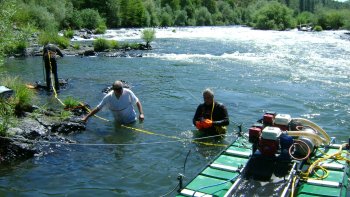
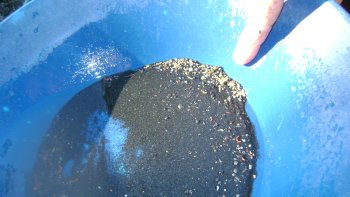
![]() While the river is designated as “recreational” by Oregon, a lot of it is land-locked by private property on both sides. This means we will need to gain access through the public access points. As a starting point on this, we have Rachel Dunn and Joelle Stine to thank for devoting a substantial amount of time going around and finding the first 25 public access points to the Rogue River (between the Gold Ray Dam and Applegate River). We will likely find more with time. These access points are all numbered on our map. The numbered links on our map will take you to our “Rogue River Access Guide” that includes images, important details and GPS coordinates for each place where you can gain access to the river. There is also a Google Earth link so that you can fly to each access point and actually look over the river from a bird”s eye view. We have also created a preliminary Lodging Guide that will list all or most of the private lodging facilities along this 37 mile stretch of the Rogue River.
While the river is designated as “recreational” by Oregon, a lot of it is land-locked by private property on both sides. This means we will need to gain access through the public access points. As a starting point on this, we have Rachel Dunn and Joelle Stine to thank for devoting a substantial amount of time going around and finding the first 25 public access points to the Rogue River (between the Gold Ray Dam and Applegate River). We will likely find more with time. These access points are all numbered on our map. The numbered links on our map will take you to our “Rogue River Access Guide” that includes images, important details and GPS coordinates for each place where you can gain access to the river. There is also a Google Earth link so that you can fly to each access point and actually look over the river from a bird”s eye view. We have also created a preliminary Lodging Guide that will list all or most of the private lodging facilities along this 37 mile stretch of the Rogue River.
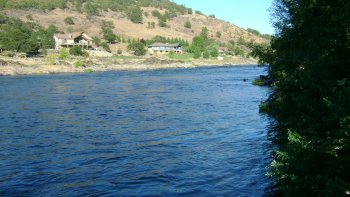
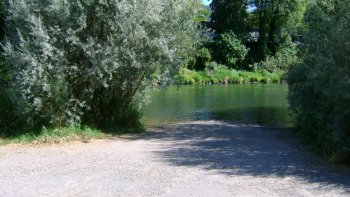
![]() Because of the limited access, I encourage you to think about bringing along a small rubber or aluminum boat with portable motor. A prop-guard is a good idea to help protect your propeller in shallow water. If you use a motorized boat on the Rogue, Oregon requires you to have a boat registration from the state where you reside (if required by your state). They also want you to pass a boating safety course which can be accomplished (free) over the Internet. A small boat will allow you to more-easily access both sides of the river upstream and downstream of the public access points in most places. This will provide you with more dredging options.
Because of the limited access, I encourage you to think about bringing along a small rubber or aluminum boat with portable motor. A prop-guard is a good idea to help protect your propeller in shallow water. If you use a motorized boat on the Rogue, Oregon requires you to have a boat registration from the state where you reside (if required by your state). They also want you to pass a boating safety course which can be accomplished (free) over the Internet. A small boat will allow you to more-easily access both sides of the river upstream and downstream of the public access points in most places. This will provide you with more dredging options.
![]() Oregon dredging regulations appear to open the Rogue River to suction dredging from 1 July through the end of August. While the rules are not as clear in Oregon as they are (were) in California, my best perception is that suction dredging on the Rogue River requires you to obtain two permits. One of them is free. You can obtain that one from the Oregon Department of State Lands with an application over the Internet. To make it simpler for you to fill out your own application, we have placed a copy of my own approved permit for 2009 on our web site.
Oregon dredging regulations appear to open the Rogue River to suction dredging from 1 July through the end of August. While the rules are not as clear in Oregon as they are (were) in California, my best perception is that suction dredging on the Rogue River requires you to obtain two permits. One of them is free. You can obtain that one from the Oregon Department of State Lands with an application over the Internet. To make it simpler for you to fill out your own application, we have placed a copy of my own approved permit for 2009 on our web site.
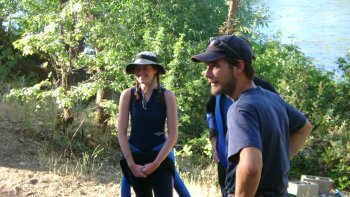 The second dredging permit is available for $25 (same fee for residents and nonresidents) by sending in your application to the Oregon Department of Environmental Quality (DEQ). You can print out the application by going to their web site. You can find a copy of my own 2009 permit application here.
The second dredging permit is available for $25 (same fee for residents and nonresidents) by sending in your application to the Oregon Department of Environmental Quality (DEQ). You can print out the application by going to their web site. You can find a copy of my own 2009 permit application here.
![]() Overall, during the week we spent there sampling, we found the local residents and other visitors to be very friendly and hospitable. Even the home owners we encountered along the sides of the river were friendly. I am speculating that because Oregon law creates a firm boundary at the high water mark, and the river is seen as a place for recreation, local residents generally do not seem to be resisting the activity.
Overall, during the week we spent there sampling, we found the local residents and other visitors to be very friendly and hospitable. Even the home owners we encountered along the sides of the river were friendly. I am speculating that because Oregon law creates a firm boundary at the high water mark, and the river is seen as a place for recreation, local residents generally do not seem to be resisting the activity.
We spent quite a lot of time in the small community of Gold Hill during the week I was over there. People are outgoingly friendly there. Everyone we talked to about what we were doing thought it was “cool!” The local dredgers we talked to (we only found a few dredgers over there) expressed sympathy about our situation in California. They were not surprised to see us working our way up into Oregon. All of the people in the rafts and fishing boats, along with the swimmers and picnickers alongside the river, were very friendly to us. There is a definite feeling of group outdoor recreational activity in the air over there.
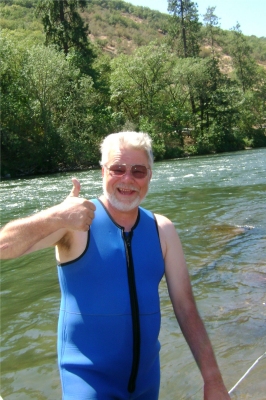
![]() While suction dredging in the active waterway is looked upon as just another recreational activity, I gather that digging holes up on the bank is frowned upon. Private property begins at the normal high water line, not far from the river in most areas. Bad idea to start digging up someone”s front yard! My impression is that the Rogue River is not the place to bring your high-banking gear. While I have not looked into it, I gather that high-banking (using a shovel to dig for gold up out of the water) requires its own permit in Oregon. So I strongly suggest you members who like to mine for gold out of the water plan to spend time along our very extensive properties just over the border in California. The Rogue River is mainly going to be an excellent suction dredging option.
While suction dredging in the active waterway is looked upon as just another recreational activity, I gather that digging holes up on the bank is frowned upon. Private property begins at the normal high water line, not far from the river in most areas. Bad idea to start digging up someone”s front yard! My impression is that the Rogue River is not the place to bring your high-banking gear. While I have not looked into it, I gather that high-banking (using a shovel to dig for gold up out of the water) requires its own permit in Oregon. So I strongly suggest you members who like to mine for gold out of the water plan to spend time along our very extensive properties just over the border in California. The Rogue River is mainly going to be an excellent suction dredging option.
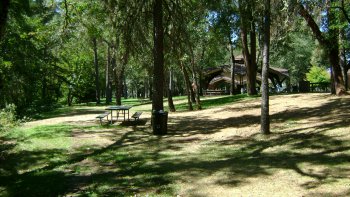
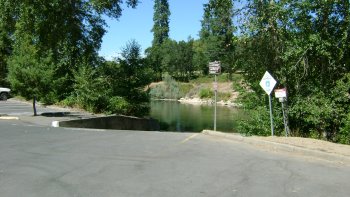
![]() There is a lot more modern structure along the Rogue than we are used to along the Klamath River. Cell phone coverage seems to extend nearly everywhere. There are roads mostly along each side of the river. There are lots of nice RV parks and different kinds of lodging facilities and sweet-looking restaurants along the river. The area is much more developed to support recreational activity.
There is a lot more modern structure along the Rogue than we are used to along the Klamath River. Cell phone coverage seems to extend nearly everywhere. There are roads mostly along each side of the river. There are lots of nice RV parks and different kinds of lodging facilities and sweet-looking restaurants along the river. The area is much more developed to support recreational activity.
![]() We are presently working on a group camping option for our members. This is not going to be as easy as it has been along the Klamath, since federal mining claims are not part of the equation. For the most part, the area seems mostly structured for visitors to plug into local private facilities. I suggest you don”t wait until the last minute to line something up. The facilities looked pretty full from what we saw, but fishing season was in high gear during our visit.
We are presently working on a group camping option for our members. This is not going to be as easy as it has been along the Klamath, since federal mining claims are not part of the equation. For the most part, the area seems mostly structured for visitors to plug into local private facilities. I suggest you don”t wait until the last minute to line something up. The facilities looked pretty full from what we saw, but fishing season was in high gear during our visit.
No Suction Dredging in California – What We are Doing About it!
As most of you have probably heard by now, Governor Schwarzenegger signed Senate Bill 670 into law which has placed a statewide moratorium on suction dredging in California until the Department of Fish & Game (DFG) completes an updated Environmental Impact Report (EIR). This EIR process has already begun. Under the present schedule, public hearings will begin in November of this year. DFG is now projecting to complete the process by the fall of 2011. If they remain on schedule (unlikely, in my own opinion), this means we will miss two dredging seasons in California.
Just in case you didn”t know, this new law only stops suction dredging within California”s active waterways. It does not have anything to do with the other types of prospecting or mining that we do in California. Unaffected prospecting activities include panning, sniping & Vack-mining, sluicing & high-banking, booming, electronic prospecting and other types of prospecting that do not use a suction nozzle within an active stream, river or creek. It also does not affect our group weekend projects.
We are Immediately Implementing a 3-Pronged Solution for California Suction Dredgers
As we are not very good at sitting around complaining, here is what we are doing:
1) Participation in the Administrative Process: The EIR on suction dredging in California must be completed through a CEQA Process (California Environmental Quality Act); which, based upon best available science, requires the authorities to identify any important concerns. Then, those concerns must be addressed through implementation of regulations which are least-restrictive upon people and economic activity. This is not new to us, since we actively participated in the earlier EIR which was completed during 1994.
We have already lined up specialist-biologists on our team who are ready to participate as the process moves forward. Our lobbyists are already busy soliciting assistance from the friends we have in the California legislature. Hopefully, some of their aids will also participate in the process, helping us to keep things on a “fair and balanced” approach and moving along towards completion as soon as possible. Our attorneys are continuing to pursue remedies in the Alameda Superior Court to help move the process along.
We will be actively involved with the Administrative process, pushing it towards completion while fighting to prevent unreasonable solutions (regulations) from being imposed upon our industry. Ultimately, if we do not overcome the new law (outlined in solution number 2 just below), completing the Administrative process is going to get dredgers back in the California waterways. We are right on top of this.
2) Challenging the New Law in Federal Court: In anticipation of the possibility that SB 670 might be signed into law, several months ago, we asked our attorneys to perform legal research to prepare ourselves for a challenge in federal court to overturn the new law. This new law is clearly flawed, and there is a reasonable chance that we can overcome it.
As always with legal matters, I have to try and present you with enough details to keep you informed, but not so much that we tip off our adversaries (who read every word published on every Internet forum having to do with mining).
To help with an explanation, here is a summary which our lead attorney has provided.
Even the U. S. Forest Service (USFS) is taking the position that the Mining Law, Organic Act and their own Section 228 regulations pre-empt the new California law. My sources are telling me that USFS will not enforce the new law and will continue to allow suction dredging on USFS lands. California may try to enforce it, but the USFS will not and will not accompany California officials in the field. My understanding is that USFS is taking the position that the U.S. Supreme Court case known as “Granite Rock“ directs only reasonable state environmental laws “of general applicability“ can apply to operations authorized by the Mining Law. It says that state or local regulations or laws “cannot say no” to mining activities on federal public or National Forest land that comply with the Section 3809 or Section 228 regulations, respectively. The Granite Rock case originated in California.
Under existing federal law, mining is the priority-use of the public lands. Regulations can only be imposed to lessen unnecessary impacts. Regulation cannot be used to prohibit mining. There is a lot of existing, controlling case law on this. Yet, without any proof that a single fish has ever been harmed by suction dredging in California under our existing suction dredge regulations, even while they continue to issue fish-kill licenses to millions of others, the State just passed a new law which declared suction dredging as “harmful,” and prohibits suction dredge mining until such time as the activity can be further studied with new regulations imposed upon our industry.
Our federal challenge will be to try and prove that a state does not have the authority to prohibit or impose unreasonable regulations upon mining on the public lands. The outcome of this challenge will most likely have an important impact upon mining in all of the states. So we must be very careful about what we do. If we win such a challenge, it is reasonable to expect all states to back off on all the unreasonable regulation of mining activity within their borders. Winning would solve a lot of problems for miners!
If we lose such a challenge, we can expect the states to step in with even more unreasonable regulations upon mining.
This leads me to the subject of how we will pay for a challenge of this new law in federal court. We need to have some certainty that there are enough supporters on our side who will help New 49’ers cover the costs. This, so we don”t make the fatal mistake of starting a fight that we cannot finish!
Most of the industry manufacturers (and others) are supportive of a federal challenge. So we have been able to pull together a very substantial list of prizes for this new fund-raiser.
The donors of these prizes have authorized our office to automatically generate a ticket in your name for every $10 legal contribution we receive ($100 would generate 10 tickets, etc). There is no limit to the size or frequency of your contributions, or to the number of prizes you can win. The drawing will take place on 4 January, 2010 at our offices in Happy Camp, California.
Legal contributions can be arranged by calling (530) 493-2012, by mailing to The New 49″er Legal Fund, P.O. Box 47, Happy Camp, CA 96039, or by clicking here:
Asking the “federal supremacy” question in federal court will most certainly affect the future of all small-scale mining (and probably even large-scale mining) in America for the foreseeable future. In my view, the responsibility is too large to place on a single attorney who is being managed by just one or two people from the whole industry. It would wise to get more organizations and more specialists involved with this. With your support, we are ready to play. Our attorneys are as good as you can find! We would like to see other organizations also actively participate.
This fund-raiser is going to be the decision-maker concerning New 49″er active involvement in a legal challenge in federal court to California”s new anti-dredging law. We will make the decision based upon how much initial financial support that we receive from you guys.
Thanks for whatever you can do!
3) Working out Suction Dredge Opportunities in Oregon: Oregon”s annual suction dredge permit presently costs $25 per year for both residents and non-residents.
We have struck high-grade gold on our dredge sampling project along the Rogue River. You will be hearing much more from us during the next few months about how we intend to support our members who wish to operate your dredges in Oregon.
Meanwhile, as you know, we continue to have the best high-banking opportunities (anywhere) along the Klamath River in Northern California for members who prefer prospecting for gold above the water.


